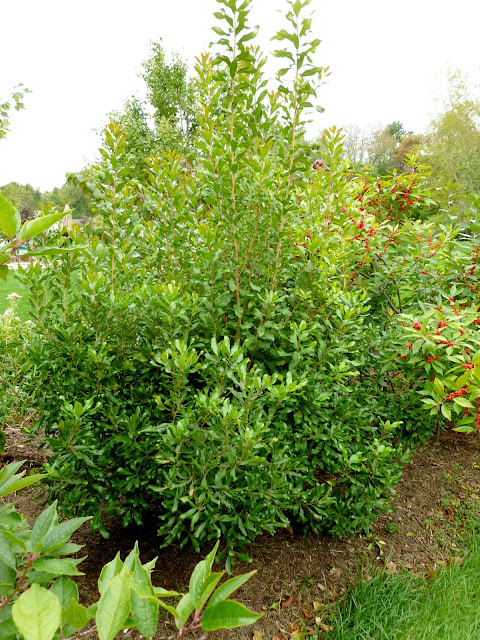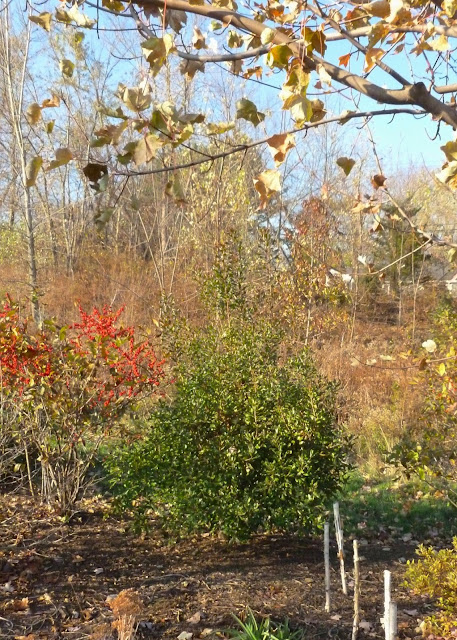Planted 8 in spring 2007.
Planted one in spring 2009.
Will colonize, suckers. Good for dry infertile sites, likes sand.
These are all gone now -- I took out the large specimen in Meadow's Edge garden in 2015.
Here's the history:
I put in the 8 one gal. containers from Forestfarm at the top of hill to screen the road, to colonize and spread out. One got crispy in September ‘07 drought. The rest were pretty scraggly looking (planting sites are difficult and sandy at the top of the hill).
By 2009 they were growing, filling in and getting quite large, although leggy. They get dark maroon in winter and hold leaves.
The one I planted in Meadow’s Edge in early 2009 was a good size from Bosco's and is huge already in winter ‘10! An excellent hedge screen at the back of that garden. It is fuller and bushier than the ones in the sand and gravel at the top of the back hill, probably because of richer soil.
 |
| May 25, 2010, leafing out kind of late |
It did get a lot of winterburn and looked pretty sad in early spring 2010, but by the end of May it was leafing out again and it greened back up.
 |
| Here's what it looked like on April 12, 2010, pretty awful |
 |
| March 28, 2011 it really gets winter burn all over |
In 2011 it was decapitated, cut in half in the October snowstorm. I trimmed it, took off the broken branches, and by late summer 2012 it had grown back, in a nice shape.
 |
| 9/26/12 |
 |
| 11/11/12 It gained height nicely and has re-formed a good shape |
The dark winter color is not attractive, and it looks a little hulking in the bare landscape.
 |
| 1/23/13 |
It finally greens up in late spring, and in the summer of 2013 it grew upright and full, regaining all of the canopy that had been lost in the 2011 storm. It started to look leafy and nice, filling the back of Meadow's Edge. The small glossy foliage and loose pyramidal form look good.
 |
| 8/6/13 |
It shone in fall with the nearby red winterberry holly berries. A nice combination.
 |
| 11/14/13 |
And when all the leaves are down, the bayberry is still deep green, glossy and a great companion with the winterberry. It becomes very noticeable at this time of year, and the regrown form looked great.
 |
| 11/21/13 |
This plant must be a male bayberry. I have never seen any gray waxy berries.
It takes forever to green up in spring. It won't have new leaves until Memorial Day. Here it is in mid May, looking pretty awful with all the things greening up around it. I don't like its late habit.
 |
| May 17, 2014 Still bare. |
It does eventually get new leaves and fill out. The glossy leaves are nice, but the plant is rangy and all over the place. It's not really a garden plant, it would be better used to naturalize areas. That's what I tried to do with the 8 planted to naturalize the back hill in 2007, but few of them have survived. The ones still up there are leggy and overtaken by other plants now.
The single specimen in the garden does some screening and offers neutral greenery at the back edge of the garden. But I'm not crazy about its wild shape or late leafing out.
 |
| September 24, 2014 |
In 2015 I finally decided this was the wrong plant in the wrong place. I took it out. It got such winter damage -- dieback, broken branches and browning, that it always looked terrible in spring. It recovered each time and filled back in, but between the damage and the tendency to leaf out very late in the season, it just looked awful early on, then went unnoticed in the background later in the summer.
It was also getting quite crowded at the back of the garden, and in the end, this plant -- a lovely leafy thing at times -- just didn't belong in this spot. Now an Ex-Plant.
Propagation:
Softwood cuttings in Spring, plant in Fall, or Semi-ripe cuttings in summer, overwinter in coldframe.